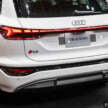You name it, DAMD has it. I’ve been harbouring the prospect of a Suzuki Jimny ever since first images of the current generation surfaced back in 2018, and a visit to the 2019 Tokyo Auto Salon – where the little 4×4 was the biggest car of that show – introduced us to DAMD, the master of deception for the JB74.
The Japanese company’s impersonation of the Mercedes-Benz G-Wagon is now a regular sight, but I’ve always preferred the more subtle Little D, modelled after the classic Land Rover Defender. You know the anatomy joke about guys with loud expensive cars? That’s why I like the Little D! One day…
Jokes aside, we were happy to bump into Little D and Little G at the 2025 Bangkok International Motor Show (BIMS) and they were hanging out with some really cool friends. From the same parents (DAMD) we have Little Delta, The Roots and a classic Little G, based on the Gelandewagen before it became an urban flex. Neighbourhood buddy Beas+ by Cal’s Motors were also at the lawn.
The most extrovert fella is Little Delta, which is inspired by none other than the Lancia Delta Integrale, the legendary rally car with Martini stripes often pictured in the air. The late 80s hero’s four-eyed headlamps and grille are unmistakable, and that famous upright rear spoiler is present. Throw in white OZ wheels and fender vents, and you have a hilariously cool rally replica Jimny.
Little Delta has a ‘European Masterpiece’ twin called Little 5, but that one – modelled after the Renault 5 Turbo with square headlamps and (non) TURBO decals – didn’t make it to Bangkok.
For those who aren’t in on the DAMD joke but like a retro-styled Jimny, take a look at The Roots. For once, the Jimny is inspired by its own considerable heritage, and this one takes after the first-generation that debut in 1970. Tiffany blue two-tone makes it look like a ‘Japanese California’ prop or a Barbie car, but The Roots looks really legit in period-correct colours like beige or yellow.
Finally, the Beas+ by Cal’s Motor, which is into the classic chrome-heavy Americana look. You’ve seen the Havana-style Toyota Raize/Perodua Ativa, now here’s that style on a more suitable canvas. The Beas+ gives off classic Chevy Blazer/Ford Bronco vibes on a similarly square body, just on a much smaller scale. Not quite a Beast.
We love the detailing (the metal grilles for the Classic G’s lights and its hood lamps, and the parody logos, among other things) and the unique sense of humour displayed by DAMD and Cal’s. These cars brought us chuckles and smiles, which were much needed after the swarm of same-same Chinese EVs at BIMS, and that’s the whole point of these things – they’re fun, and they’re just for fun. Thank you Suzuki Jimny for being the perfect canvas!
GALLERY: Modified Suzuki Jimnys at BIMS 2025



















































































































































































































































































































































































































































